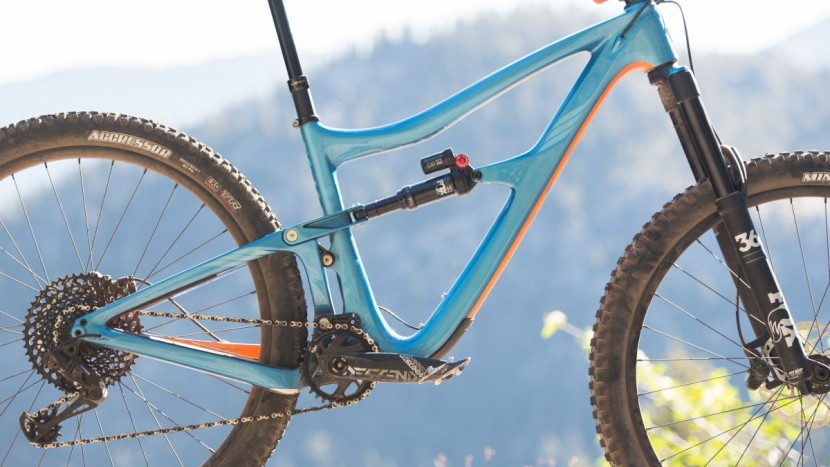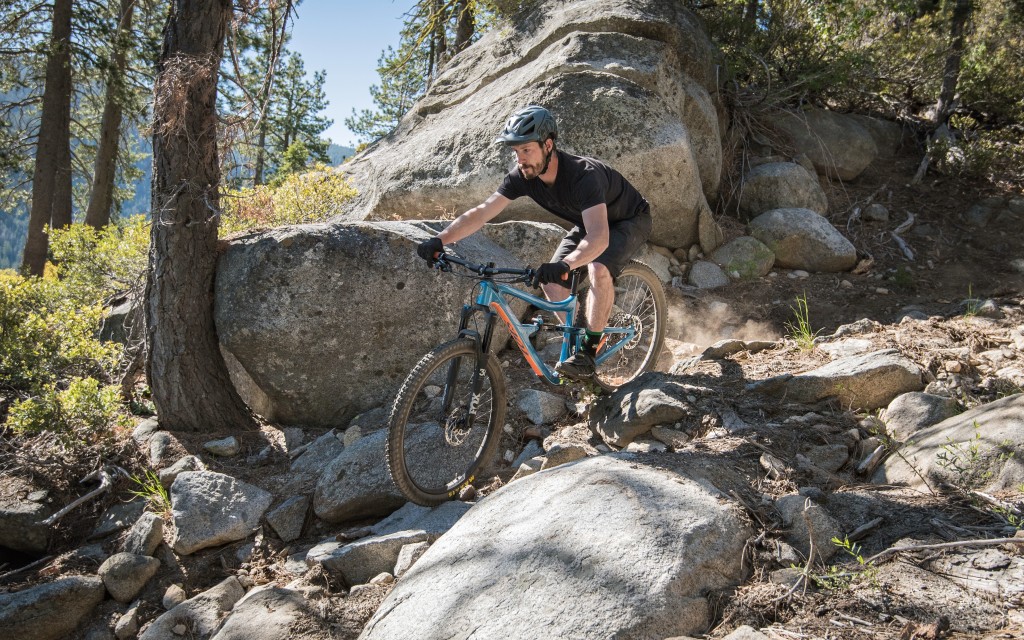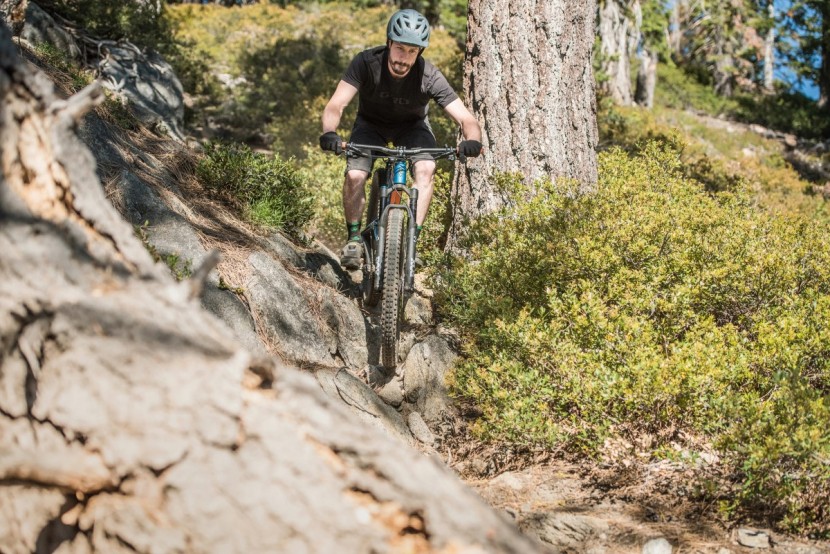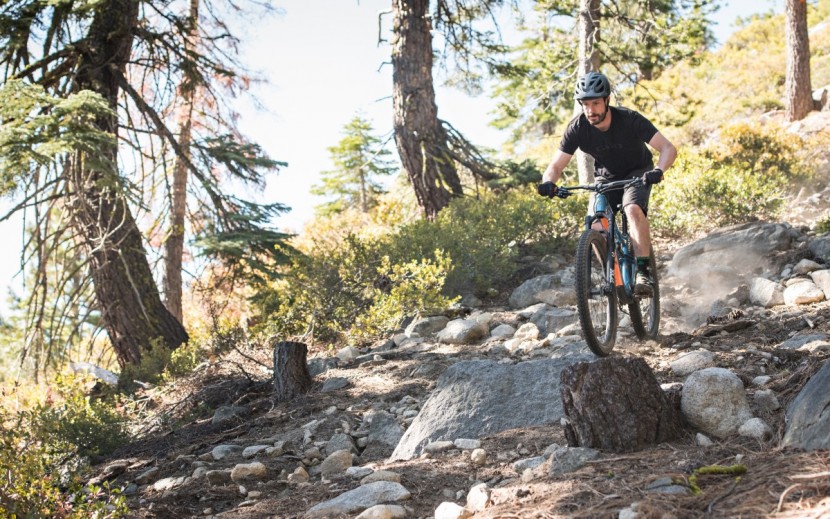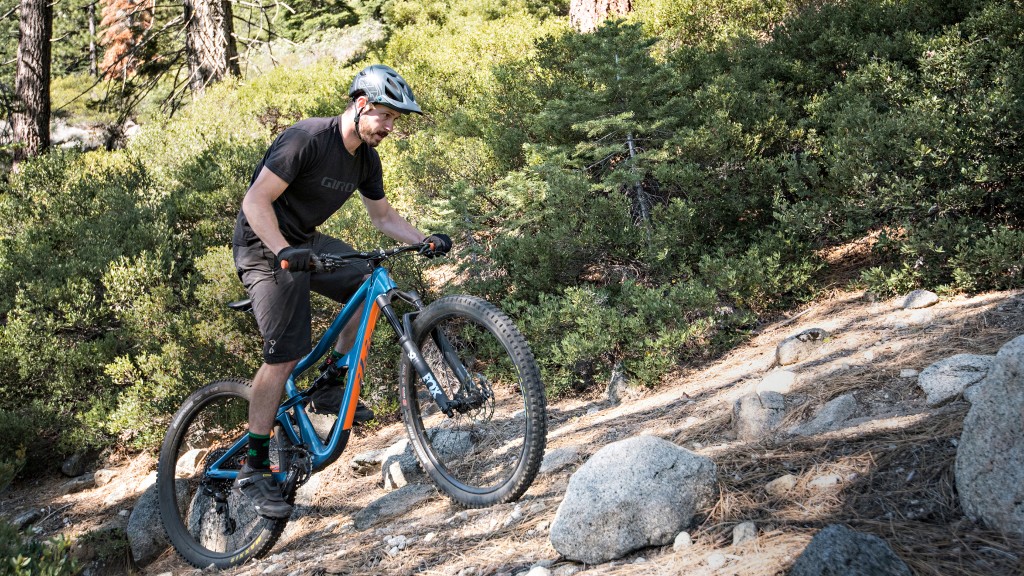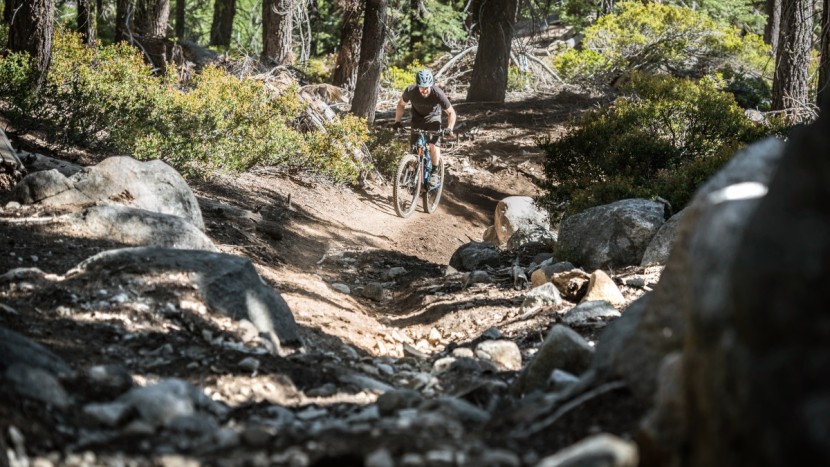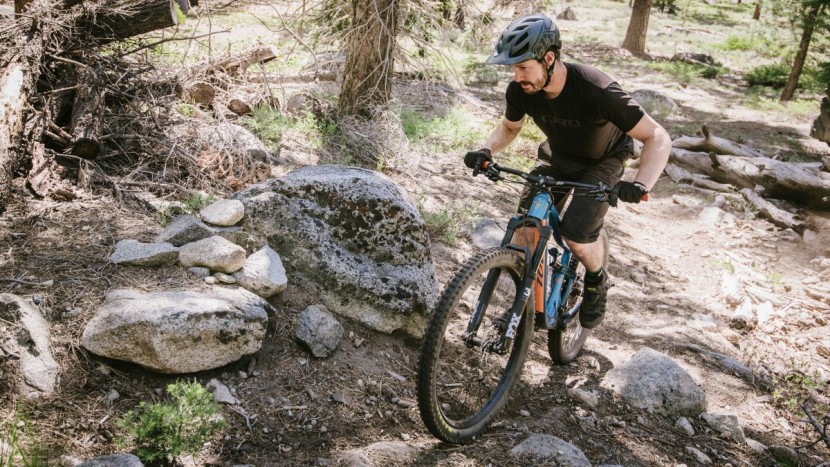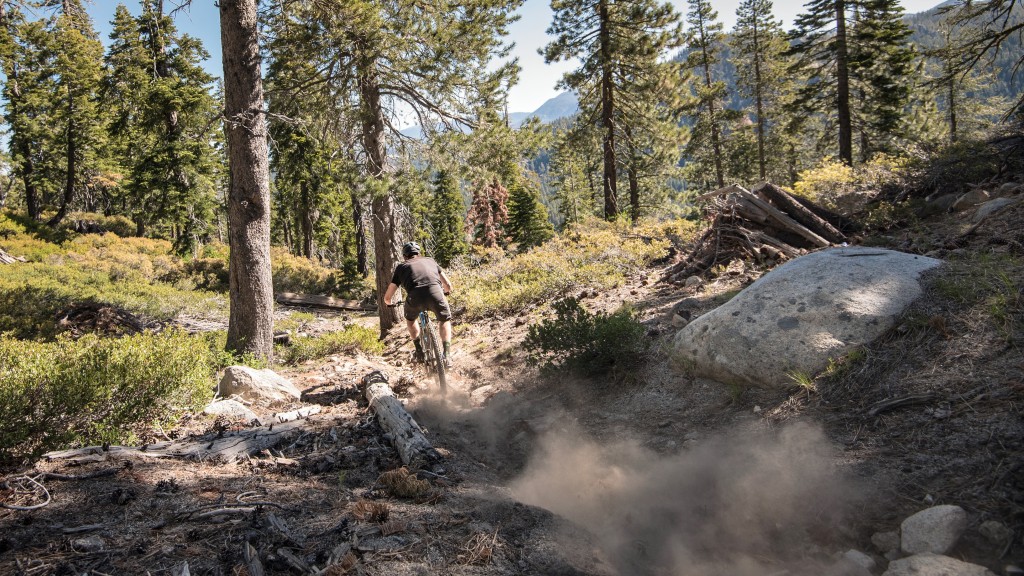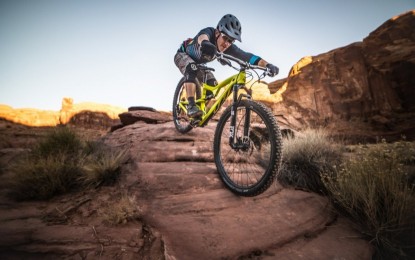Ibis Ripmo GX 2018 Review
Our Verdict
Our Analysis and Test Results
The carbon Ripmo got an update for 2020. After an overwhelming response to the aluminum-framed Ripmo AF, Ibis added a little length in the reach, slackened the head angle by a full degree, made the rear suspension more progressive, and made room for compatibility with coil shocks. We recently tested the new and improved Ripmo V2. May 2020
Should I Buy This Bike?
The Ripmo is a high-end, light enduro/aggressive trail bike. It is an excellent option for the rider who wants aggressive geometry with a sporty design. This bike has a mean attitude in rock gardens and steep trails while retaining an athletic and sporty feel. The combination of hard-charging abilities and a lively, finesse, feel is very difficult to come by. Riders who want long travel capability with mid-travel snappiness, handling, and acceleration will love this bike. The Ripmo is capable of long days in the saddle despite its long wheelbase and burly feel. This bike is an impressively efficient climber and it handles well in tight and technical terrain compared to similar bikes in this travel range. If you're a rider seeking enduro performance while retaining sharp handling and excellent climbing abilities, we think this is one of the best options on the market.
The new Santa Cruz Hightower is another excellent upper mid-travel 29er trail bike. The 2020 redesign has made the Hightower longer, slacker, and much harder charging than the previous versions. It now has a mini-enduro bike feel with outrageous stability at speed and a confident and composed feel when the going gets steep and rough. The Hightower has traded a bit of maneuverability and liveliness for its new more aggressive attitude, and it doesn't feel quite as sporty or quick as the Ripmo at low speeds or in tight sections of trail. We feel the Ripmo is a bit more well-rounded overall, though the Hightower feels a bit more eager to charge the fall-line.
The Yeti SB 130 is another stellar all-around trail bike. It has 130mm of rear-wheel travel paired with a 150mm fork, so it falls more in the mid-travel category when compared to the Ripmo. The Yeti has a modern geometry, an excellent build, and well-rounded and versatile performance similar to the Ripmo. Depending where and how you ride, the SB 130 may make more sense for you. It is fully capable of taking on the same terrain as the Ripmo, though the reduction in travel will likely suit riders who don't frequent gnarly terrain often a little better.
Frame Design
The Ripmo features DW-Link suspension. This is a dual link system with one link located above the bottom bracket and another approximately halfway up the seat tube. Both links rotate in the same direction as the bike moves through its travel. This design offers excellent pedaling efficiency and functions well under braking forces. One downside is questionable small bump compliance.
Our large Ripmo GX has a measured 628mm effective top tube and 473mm reach. The chainstays measure 436mm and the wheelbase is 1220mm. The head tube angle is 65.8-degrees and the seat tube angle measures a steep 76.1-degrees. The bike hit the scales at an impressive 29 lbs 7 oz without pedals or tubes.
We highly recommend sitting on this bike before pulling the trigger. The reach numbers are generous but the steep seat tube angle makes the cockpit feel tighter than the reach number suggests. In addition, the short seat tube makes setting saddle height difficult. Our 6'2" tester had the post raised to the minimum insertion point to find a comfortable pedaling height.
Design Highlights
- 29-inch wheels only
- 145mm of rear-wheel travel
- Designed around 160mm fork
- Features a reduced offset fork
- Clearance for up to 2.6-inch tires
- Frame only for $2999
- Build kits ranging from $4,199 to $9,299
Downhill Performance
The Ripmo is a confident descender that lives for high speeds and offers excellent stability. This sleek shredder has the angles and attitude to inspire riders to feed it down gnarly and steep terrain. Cornering abilities are excellent and the sporty rear end provides a lively ride.
The Ripmo has a sporty and responsive rear end. The DW-Link suspension is effective and supportive and remains very athletic. This is not the kind of bike that has a pillowy and bottomless feel. The 145mm of suspension is a little tighter and firmer compared to some longer travel enduro bikes such as the Evil Insurgent, Santa Cruz Nomad, or Commencal Meta AM. This creates a more responsive and nimble feel. It is easy to load the rear end up and hop in and out of rock gardens or to get a little playful. The front end is mean and capable. Take an ultra-aggressive Maxxis Minion DHF 2.5 WT and pair it with a burly 160mm Fox 36 fork. The result is an extremely confident front end that inspires riders to attack aggressive or steep lines.
This bike was impressive motoring through chatter and chunder. The bike remains in control and impressively quiet. It was relatively easy to find shock pressures and rebound settings that worked well on the Fox DPX2. Steeper terrain doesn't deter the Ripmo and riders should be confident rolling into any chute. Larger impacts were less composed. This is by no means a debilitating flaw, but bigger hits have the ability to shake the confidence of the Ripmo. The Hightower has far better deep stroke support.
This bike operates well with a dose of speed. The long geometry paired with the feisty tires instills confidence. High-speed cornering abilities are extremely impressive. Even on loose and sandy corners, the 2.5-inch Minion DHF WT pulls the bike through. No matter the trail surface, the Ripmo rails corners. Given the width of these tires, testers ran pressures as low as 21-22 PSI. The 34mm Ibis hubs provide an excellent footprint. Traction was fantastic over everything from loose, sandy trails to off-camber roots and rocks. Despite the mean front end and 1220mm wheelbase, negotiating tight downhill turns is easy.
The Ripmo is a relatively user-friendly bike. This bike doesn't fall into the same category of super-enduro bikes like the Santa Cruz Nomad that requires a super aggressive pilot or mach speeds. Anyone can enjoy this bike and it doesn't require huge amounts of body language or muscle to slap it into turns or maneuver over obstacles. There is no denying the Ripmo feels better and better at high speeds, but it isn't a requirement. Two testers noted that the Ibis branded bars have a large 9-degree back sweep and provide a disconcerting, twitchy, feel.
The 160mm Fox 36 Performance fork is confident. The Performance model comes with a GRIP damper as opposed to the more adjustable GRIP2 damper or Fit4 found on higher-end Fox 36 models. This fork worked well enough on this bike and provided a stiff and supportive feel. The 2.5-inch Maxxis Minion DHF WT front tire is a tremendous specification as it only adds to the already confident front end. The fast-rolling Maxxis Aggressor 2.5-inch rear tire rolls fast while still offering sufficient braking bite. A few components that stood out as weak on the descent were the Shimano Deore brakes and the Ibis handlebars. The Deore brakes simply weren't powerful enough to confidently shut down the speed that the Ripmo craves.
Climbing Performance
The Ripmo is a stellar climber. This burly bicycle has a pleasantly calm and firm pedal platform that doesn't sacrifice traction. The frame geometry is excellent for putting the power down and retains reasonable handling despite its slack front end. The component grouping works very well on the inevitable uphill grind.
This bike has a steep 76.1-degree seat tube angle that puts rider smack dab on top of the cranks. Typically, the more aggressive bikes have slacker seat tube angles which position the rider slightly behind the cranks and is detrimental to power transfer. The Ripmo puts you in a great place to maximize power transfer. The front end of the bike is big and slack but doesn't seem to negatively affect the climbing position. The 343mm bottom bracket height helps this bike cleanly crawl over rocks and roots and largely avoids pedal strikes.
On the ascent, the Ripmo works quite well with the shock wide open. In or out of the saddle, the bike is reasonably calm and resists bobbing. Anti-squat is a technical design term to describe how a bike resists pedal bob or bouncing. High anti-squat numbers are nice but can sometimes be detrimental to climbing traction. A prime example of this is how the Yeti SB5.5 has less anti-squat and a more active suspension design. The Yeti provides great climbing traction over technical terrain. The Santa Cruz Hightower has much more anti-squat, and while it is an efficient pedaller, traction can suffer on technical climbs. The Ripmo splits the difference and blends a very efficient pedal platform with excellent traction. It should not be overlooked that some of this is likely due to the wide tire/rim combination and lower tire pressures.
Navigating uphill rock gardens is reasonably confident and easy. Given the slack geometry and relatively shorter 436mm chainstays, the front wheel can lift and wander on steeper pitches. As with most enduro/aggressive trail bikes, tight uphill switchbacks can require some attention. A clean and crafty entry goes a long way.
The component grouping on our GX Ripmo worked well on the climb. The GX Eagle drivetrain is always a favorite. A light, 30:50-tooth, climbing gear offers an airy and relaxing bailout gear on long climbs or epic days. The Ibis 938 rims feature a 34mm inner diameter and create an excellent footprint. The Maxxis Minion DHF and Aggressor 2.5-inch tires are no featherweights coming in over 1000 grams each. We feel it is worth pushing some extra weight for the added downhill performance. Weight weenies could consider some narrower rubber to help create a lighter feel.
Photo Tour
Value
Our Ripmo GX retails for $5,099 with a build kit that features the typical highlights and lowlights. Given the fantastic on-trail performance, it is easy to call this bike a strong value. Yes, you can find a bike with similar geometry travel numbers at a lower price, but the Ripmo offers truly high-end performance with a dialed suspension design. The cost of entry is lofty, but for riders seeking top-notch performance, the Ripmo should be on your shortlist.
Conclusion
Ibis took a sporty and athletic approach with their entry into the popular long-travel 29er category. The Ripmo has all of the aggressive angles to attack an enduro race course while retaining a snappy and sharp-handling personality. We love it. If you're searching for a capable daily driver that retains impressive climbing abilities, the Ripmo is worth a look.




